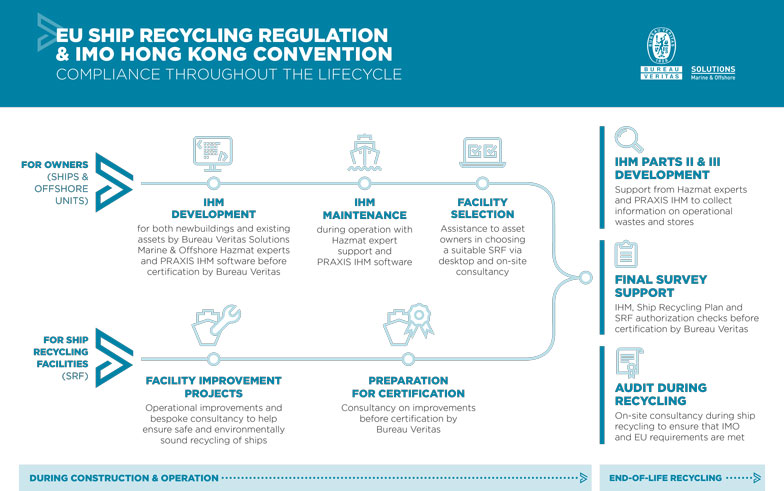Developed with input from the International Maritime Organisation (IMO) and its members, the Inventory of Hazardous Materials was introduced in the 2009 Hong Kong International Convention for the Safe and Environmentally Sound Recycling of Ships.
The inventory of hazardous materials was introduced to ensure the safety of all those who could potentially be exposed to hazardous materials (including workers in shipyards, on the ships and at recycling yards), by providing a comprehensive list of hazardous materials onboard the ship.
Briefly, the Hong Kong Convention requires ship owners to:
- When the Convention comes into force, all ships will be required to have an initial IHM survey followed by surveys throughout the ships life
- Ships being sent for recycling must have an up to date IHM (specific to each ship). Prior to the ship arriving at the recycling facility, the ship must have an end of life IHM
- Shipyard recycling facilities must provide a Ship Recycling Plan that details the method used to dismantle the ship, accounting for the information provided in the IHM survey
- The IHM must be conducted by a qualified supplier to ensure the IHM is accurate and resists unnecessary potential risks to both individuals and the environment
According to the new rules, the installation or use of certain hazardous materials on ships will be prohibited or restricted. These hazardous materials include for instance asbestos and ozone-depleting substances.
Currently the Hong Kong Convention is not compulsory. However, when the convention becomes compulsory, expected within the next couple of years, all ships weighing over 500GT will be required to carry the inventory. In the meantime the EU has introduced regulations that all ships visiting EU ports will have to have an approved IHM by December 2020.
Regulation (EU) No 1257/2013 – “Ship Recycling Regulation”
The EU Ship Recycling Regulations follow a very similar structure to HKC. The regulation, however, does set out some additional requirements for compliance which must be achieved by all vessels exceeding 500GT, carrying the flag of a European Member State, calling at a European Port or operating in European Waters, ahead of the deadline of 31 December 2020. These further obligations include consideration for additional hazards during IHM compilation. Namely; PFOS (Perfluorooctanesulfonic Acid) and HBCDD (Hexabromocyclododecane).
What is included in a Lucion IHM Survey?
Hazards that are commonly found on vessels include Asbestos, polychlorinated biphenyls (PCBs), Organotin Compounds, inc TBTs and microbiological contaminants, Ozone Depleting Substances (ODS), Heavy Metals, Polybrominated biphenyl (PBBs), Polybrominated diphenyl ethers (PBDEs), Polychlorinated naphthalenes (PCN – more than 3 chlorine atoms), Radioactive substances, Certain short chain chlorinated paraffins (SCCP – Alkanes, C10-C13, chloro), Perfluorooctanesulfonic Acid (PFOS) and Hexabromocyclododecane (HBCDD).
- Collation of necessary information
- Visual Sampling Check Plan (VSCP) – assessment of vessel information.
- Onboard verification and sampling survey – validates the information within the VSCP and with verification through sampling
- Sample Analysis
- Interpretation of analysis results and IHM Report delivery (in Classification specific format, where required)
The survey can take place while the vessel is at sea or in port and our surveying teams are able to meet and leave the vessel at most ports internationally.
The IHM should undergo annual verification to ensure its relevance and a full re-survey of the vessel carried out every five years.
How long does an IHM Survey take?
The length of time to conduct an IHM Survey can vary depending on the size of the vessel, how the vessel is currently being used (if the vessel is live i.e. commercial passenger ship will take longer than a tanker that is largely unoccupied), the amount of potential hazardous materials on board, and any unforeseen logistical issues.
Why should I use Lucion to conduct my IHM Survey?
Whilst it is not a requirement by the Hong Kong Convention to use a qualified supplier to conduct your IHM Survey, it is recommended to do so to ensure that your vessel is comprehensively and accurately surveyed in a safe manner that resist unnecessary exposure to any onboard hazards. Sampling should be carried out by a competent IHM expert. Testing and analysis should be conducted at accredited ISO 17025 laboratories or equivelant.
As an established international Hazardous Materials testing, inspection, and consultancy provider, our team of specialist shipboard hazardous material experts are trusted to deliver our services to multiple clients throughout the world.
Lucion holds approval status with major IACS Classification Societies, including Lloyds Register, Bureau Veritas, American Bureau of Shipping (ABS) as well as having directly employed DNV GL certified Marine HazMat Experts.
What are my responsibilities?
The impact of poor ship recycling decisions has been heavily documented over recent years. To combat this negative impact on individuals and the environment, the European Union adopted the Hong Kong Convention 2009 early (in 2013) which outlines requirements that ships flying the flag of Member States of the Union and recycling facilities within the EU have to fulfil in order to make sure that ship recycling takes place in an environmentally sound and safe manner.
If you are a ship or fleet owner bearing the EU member states flag, you are required by law to conduct an initial IHM Survey by December 2020. Our team provides surveys for hazardous materials on vessels around the world, whether they are newly built, currently trading, or due to be recycled.
Source: lucionmarine








 IHM Life Cycle Solution we provide a turnkey IHM (Inventory of Hazardous Materials) / Green Passport solution for shipowners that has been approved by DNV GL, ABS, Lloyd’s Register, BV, Class NK, RINA and Korean Register.
IHM Life Cycle Solution we provide a turnkey IHM (Inventory of Hazardous Materials) / Green Passport solution for shipowners that has been approved by DNV GL, ABS, Lloyd’s Register, BV, Class NK, RINA and Korean Register.




